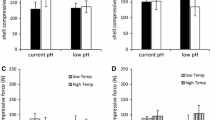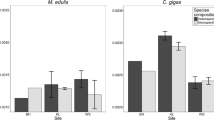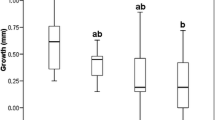Abstract
The ability of an invasive species to spread in a new locality depends on its interaction with the indigenous community and on variation in time and space in the environment. The Mediterranean mussel Mytilus galloprovincialis invaded the South African coast 30 years ago and it now competes and coexists with the indigenous mussel Perna perna. The two species show different tolerances to wave and sand stress, two of the main environmental factors affecting this intertidal community. P. perna is more resistant to hydrodynamic stress than M. galloprovincialis, while the invasive species is less vulnerable to sand action. Our results show that mortality rates of the two species over a period of 6 months had different timing. The indigenous species had higher mortality than M. galloprovincialis during periods of high sand accumulation in mussel beds, while the pattern reversed during winter, when wave action was high. A negative correlation between sand accumulation and attachment strength of the two mussels showed that sand not only affects mussel mortality through scouring and burial, but also weakens their attachment strength, subjecting them to a higher risk of dislodgement. Here we underline the importance of variations in time and space of environmental stress in regulating the interaction between invasive and indigenous species, and how these variations can create new competitive balances.



Similar content being viewed by others
References
Bally R, McQuaid CD, Brown AC (1984) Shores of mixed sand and rock: an unexplored marine ecosystem. S Afr J Sci 80:500–503
Bownes SJ, McQuaid CD (2006) Will the invasive mussel Mytilus galloprovincialis Lamarck replace the indigenous Perna perna L. on the south coast of South Africa? J Exp Mar Biol Ecol 338:140–151
Branch GM, Steffani CN (2004) Can we predict the effects of alien species? A case-history of the invasion of South Africa by Mytilus galloprovincialis (Lamarck). J Exp Mar Biol Ecol 300:189–215
Bustamante RH, Branch GM (1996) The dependence of intertidal consumers on kelp-derived organic matter on the west coast of South Africa. J Exp Mar Biol Ecol 196:1–28
Calvo-Ugarteburu G, McQuaid CD (1998) Parasitism and invasive species: effects of digenetic trematodes on mussels. Mar Ecol Prog Ser 169:149–163
Carlton JT (1999) Molluscan invasions in marine and estuarine communities. Malacologia 41:439–454
Castilla JC, Guinez R, Caro AU, Ortiz V (2004) Invasion of a rocky intertidal shore by the tunicate Pyura praeputialis in the Bay of Antofagasta, Chile. Proc Natl Acad Sci USA 101:8517–8524
Castilla JC, Uribe M, Bahamonde N, Clarke M, Desqueyroux-Faundez R, Kong I, Moyano H, Rozbaczylo N, Santelices B, Valdovinos C, Zavala P (2005) Down under the southeastern Pacific: marine non-indigenous species in Chile. Biol Invasions 7:213–232
Chesson P (2000) General theory of competitive coexistence in spatially-varying environments. Theor Popul Biol 58:211–237
Cheung SG, Shin PKS (2005) Size effects of suspended particles on gill damage in green-lipped mussel Perna viridis. Mar Pollut Bull 51:801–110
Daly MA, Mathieson AC (1977) The effects of sand movement on intertidal seaweeds and selected invertebrates at Bound Rock, New Hampshire, USA. Mar Biol 43:45–56
Davis MA, Grime JP, Thompson K (2000) Fluctuating resources in plant communities: a general theory of invisibility. J Ecol 88:528–534
Denny MW (1987) Lift as a mechanism of patch initiation in mussel beds. J Exp Mar Biol Ecol 113:231–245
Denny MW, Helmuth B, Leonard G, Harley CDG, Hunt LJH, Nelson EK (2004) Quantifying scale in ecology: lessons from a wave-swept shore. Ecol Monogr 74:513–532
Devinny JS, Volse LA (1978) Effect of sediments on the development of Macrocystis pyrifera gametophytes. Mar Ecol 48:343–348
Erlandsson J, Pal P, McQuaid CD (2006) Re-colonization rate differs between co-existing indigenous and invasive intertidal mussels following major disturbance. Mar Ecol Prog Ser 320:169–176
Grant WS, Cherry MI (1985) Mytilus galloprovincialis Lmk. in South Africa. J Exp Mar Biol Ecol 90:179–191
Griffiths CL, Hockey PAR, Van Erkom Schurink C, Le Roux PJ (1992) Marine invasive aliens on South African shores: implications for community structure and trophic functioning. S Afr J Mar Sci 12:713–722
Harris JM, Branch GM, Elliott BL, Currie B, Dye AH, McQuaid CD, Tomalin BJ, Velasquez C (1998) Spatial and temporal variability in recruitment of intertidal mussels around the coast of southern Africa. S Afr J Zool 33:1–11
Helmuth B, Denny MW (2003) Predicting wave exposure in the rocky intertidal zone: do bigger waves always lead to larger forces? Limnol Oceanogr 48:1338–1345
Hicks DW, Tunnell JW, McMahonrf (2001) Population dynamics of the non-indigenous brown mussel Perna perna in the Gulf of Mexico compared to other world-wide populations. Mar Ecol Prog Ser 211:181–192
Hockey CL, van Erkom Schurink C (1992) The invasive biology of the mussel Mytilus galloprovincialis on the southern African coast. Trans R Soc S Afr 48:123–139
Littler MM, Martz DR, Littler DS (1983) Effects of recurrent sand deposition on rocky intertidal organisms: importance of substrate heterogeneity in a fluctuating environment. Mar Ecol Prog Ser 11:129–139
Lubchenco J, Menge BA (1978) Community development and persistence in a low rocky intertidal zone. Ecol Monogr 48:67–94
Mack RN, Simberloff D, Lonsdale WM, Evans H, Clout M, Bazzaz FA (2000) Biotic invasions: causes, epidemiology, global consequences, and control. Ecol Appl 10:689–710
Marshall DJ, McQuaid CD (1989) The influence of the respiratory response on the tolerance to sand inundation of the limpets Patella granularis (L) (Prosobranchia) and Siphonaria capensis (Q et G) (Pulmonata). J Exp Mar Biol Ecol 129:191–201
McQuaid CD, Dower KM (1990) Enhancement of habitat heterogeneity and species richness on rocky shores inundated by sand. Oecologia 84:142–144
Menge BA (1976) Organization of the New England rocky intertidal community: role of predation, competition, and environmental heterogeneity. Ecol Monogr 46:355–393
Moyle PB, Light T (1996) Fish invasions in California: do abiotic factors determine success? Ecology 77:1670–1675
Nalepa TA, Schloesser DW (eds) (1993) Zebra mussels: biology, impacts, and control. Lewis Publishers/CRC, Boca Raton
Newell RC (eds) (1970) Biology of intertidal animals. Logos, London
Orensanz JM, Schwindt E, Pastorino J, Bortolus A, Casas G, Darrigran J, Elias R, Lopez GJJ, Obenat S, Pascual M, et al (2002) No longer the pristine confines of the world ocean: a survey of exotic marine species in the southwestern Atlantic. Biol Invasions 4:115–143
Paine RT, Levin SA (1981) Intertidal landscapes: disturbance and the dynamics of pattern. Ecol Monogr 51:145–178
Robinson TB, Griffiths CL, McQuaid CD, Rius M (2005) Marine alien species of South Africa—status and impacts. Afr J Mar Sci 27:297–306
Schneider KR, Wethey DS, Helmuth BST, Hilbish TJ (2005) Implications of movement behaviour on mussels dislodgment: exogenous selection in a Mytilus spp. hybrid zone. Mar Biol 146:333–343
Shea K, Chesson P (2002) Community ecology theory as a framework for biological invasions. Trends Ecol Evol 17:170–176
Sher AA, Hyatt LA (1999) The disturbed-resource invasion matrix: a new framework for predicting plant invasions. Biol Invasions 1:109–114
Steffani CN, Branch GM (2003) Growth rate, condition, and shell shape of Mytilus galloprovincialis: responses to wave exposure. Mar Ecol Prog Ser 246:197–209
Taylor PR, Littler MM (1982) The role of compensatory mortality, physical disturbance, and substrate retention in the development and organization of a sand-influenced, rocky-intertidal community. Ecology 63:135–146
Tolman HL (1999) User manual and system documentation of WAVEWATCH-III version 1.18. Technical note no. 166. Ocean Modeling Branch, NCEP, National Weather Service, NOAA, Department of Commerce, 110pp
van Erkom Schurink C, Griffiths CL (1993) Factors affecting relative rates of growth in four South African mussel species. Aquaculture 109:257–273
Veltman CJ, Nee S, Crawley MJ (1996) Correlates of introduction success in exotic New Zealand birds. Am Nat 147:542–557
Williamson M (1996) Biological invasions. Chapman & Hall, London
Zardi GI, Nicastro KR, Porri F, McQuaid CD (2006a) Sand stress as a non-determinant of habitat segregation of indigenous (Perna perna) and invasive (Mytilus galloprovincialis) mussels in South Africa. Mar Biol 148:1031–1038
Zardi GI, Nicastro KR, McQuaid CD, Rius M, Porri F (2006b) Hydrodynamic stress and habitat partitioning between indigenous (Perna perna) and invasive (Mytilus galloprovincialis) mussels: constraints of an evolutionary strategy. Mar Biol 150:78–88
Zardi GI, McQuaid CD, Nicastro KR (2007) Balancing survival and reproduction: seasonality of wave action, attachment strength and reproductive output in indigenous Perna perna and invasive Mytilus galloprovincialis mussels. Mar Ecol Prog Ser 334:155–163
Acknowledgements
This research was funded by a postdoctoral research fellowship from the Claude Harris Leon Foundation awarded to GIZ, Rhodes University and the National Research Foundation of South Africa.
Author information
Authors and Affiliations
Corresponding author
Additional information
Communicated by C.L. Griffiths.
Rights and permissions
About this article
Cite this article
Zardi, G.I., Nicastro, K.R., McQuaid, C.D. et al. Sand and wave induced mortality in invasive (Mytilus galloprovincialis) and indigenous (Perna perna) mussels. Mar Biol 153, 853–858 (2008). https://doi.org/10.1007/s00227-007-0857-z
Received:
Accepted:
Published:
Issue Date:
DOI: https://doi.org/10.1007/s00227-007-0857-z




